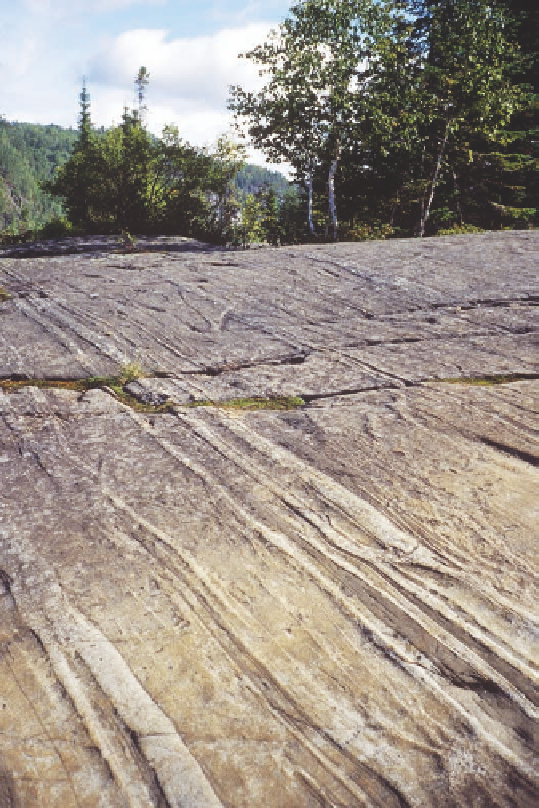Geoscience Reference
In-Depth Information
Landforms Made by Glacial Erosion
Erosion by glaciers occurs mainly through the processes of
abrasion and plucking.
Glacial abrasion
takes place because
the moving ice contains particles of sand or rock fragments that
are frozen to the bottom of the ice. As the ice moves, these frag-
ments scratch and gouge the underlying bedrock. Such abrasion
can result in
glacial striations
or scratches that indicate the di-
rection of glacial movement (Figure 17.13). When the scratches
are particularly deep and well expressed, they are called
glacial
grooves
.
Another form of glacial erosion is
glacial plucking
,
which happens when a glacier pulls large rocks or boulders
from the ground as it moves. These boulders are subsequently
carried within the ice or are frozen to the bottom of the gla-
cier, where they act as tools for abrasion. When the glacier
melts and retreats, it drops the boulders in what appear to be
very random locations. These isolated boulders are known as
glacial erratics
because they appear to be out of place since
they are now far from their natural outcrops. A great example
of glacial plucking and long-distance transport can be seen
in the Sioux Quartzite in the midwestern United States. This
rock unit is a Precambrian quartzite that crops out in south-
western Minnesota at several places, including Pipestone
National Monument. This area was overridden and leveled
during the ice ages when a massive continental glacier peri-
odically reached from northeastern Canada to southern Illi-
nois. (This history will be discussed in more detail later in the
chapter.) One such advance of the ice plucked rocks from the
Pipestone region and carried them to southeastern Nebraska
and northeastern Kansas, where they were dropped as glacial
erratics (Figure 17.14).
The combined processes of glacial abrasion and plucking
scrape and round the hills. The most distinctive landform pro-
duced by these combined processes is the roche moutonnée. A
roche moutonnée
is a rounded bedrock hill that has a gradual
slope on one side, called the stoss side, and a steep slope on the
other, the lee side (Figure 17.15). The stoss side faces the direc-
tion from which the glacier came and was smoothed by abra-
sion as the ice moved over it. The lee side is steeper and more
irregular with respect to its surface because the ice plucked rock
from this side of the hill.
Although glacial erosion occurs in both alpine and con-
tinental environments, its effects are typically more visible in
Figure 17.13 Glacial striations.
Glacial striations such as
these in Minnesota are linear scratches in bedrock produced
when rocks at the bottom of a glacier grind across the bedrock.
section, glacial landforms are divided into two groups:
(1) landforms created mainly by erosion and (2) landforms
produced mainly by deposition. The actual processes as-
sociated with glacial erosion and deposition are discussed
in some detail.
Glacial abrasion
An erosional process caused by the grinding
action of a glacier on rock.
Glacial plucking
An erosional process by which rocks are
pulled out of the ground by a glacier.
Scratches in rock produced by glacial
Glacial erratics
Large boulders that have been plucked and
transported a great distance before they are deposited.
Glacial striations
abrasion.
Deep furrows in rock produced by-glacial
Roche moutonnée
A landform produced by glacial abrasion
and plucking that has a shallow slope on one side and a steep
slope on the other side.
Glacial grooves
abrasion.

